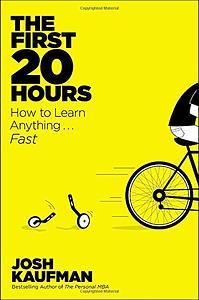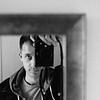Take a photo of a barcode or cover
informative
inspiring
lighthearted
medium-paced
The first three chapters offer great advice on how to intelligently set yourself up to learn a new skill with the least amount of time investment. The rest of the book offer examples of the author putting these methods to practice - a bit boring sometimes and didn’t add much value to the core concepts of the book presented earlier, but I did enjoy learning about some new skills I hadn’t previously been interested in.
The start of the book was good, the end was great. The middle was just semi irrelevant tutorials and how he learned new skills. Would of been great if he talked about learning physical, mental, cognitive, academic, etc. And dived into the science and reasoning behind learning techniques and methods.
Overall and OK book.
Overall and OK book.
inspiring
medium-paced
My advice, if in any case this book falls into your hand, read only the first 3 chapters. The rest of the book is about the author's personal experience in learning the skills he is interested in. I mean I want to know how I can learn things fast, but that doesn't mean I should read a book that's all about Yoga and programming which makes the majority pages of this book.
I really enjoyed the first three chapters of this book. I started taking notes, and got really excited about learning new skills. The rest of the book, however, was all about the author’s experience learning new skills. This would have been fine if it was written along the lines of “I learned this new skill over a period of two months by doing these things, and realized that I needed to tweak my methods by doing XYZ.” The problem was the vast amount of space each chapter dedicated to…teaching the reader the skills the author learned.
I’m not particularly interested in learning how to windsurf, or play Go, or type on a new keyboard layout. I don’t know anything about computer programming, and I’m actually ok with that. I didn’t need lessons on how websites work or sailing directions, unless they specifically pertained to the subject matter of the book - which they seldom did.
I went back and re-read the first three chapters again, and decided that’s all one really needs out of this book. The rest is pretty much filler.
I’m not particularly interested in learning how to windsurf, or play Go, or type on a new keyboard layout. I don’t know anything about computer programming, and I’m actually ok with that. I didn’t need lessons on how websites work or sailing directions, unless they specifically pertained to the subject matter of the book - which they seldom did.
I went back and re-read the first three chapters again, and decided that’s all one really needs out of this book. The rest is pretty much filler.
Everyone has something that they want to master or become better at and Josh Kaufman is here to help with his book First 20 Hours. The book sets up a theoretical basis for learning faster and takes the reader on a journey of learning as Josh Kaufman uses Yoga, Programming, and the Ukulele among other things as proof of concept.
Takeaways:
- Skills and abilities grow with persistence
- Leaning into initial discomfort will enable major progress
- Practicing an hour or so before sleeping will enhance your ability to learn.
My main critique of The First 20 Hours is that it comes across as a collection of tutorials and by extension a bit show-offish because there is a disconnection between the application of the theoretical part and the practical part. The tutorial parts don't carry the theory with them and as I reached the ending chapters I realized that I had forgotten what the theory was. It would be nice if Josh Kaufman had ended each chapter with an explicit walkthrough of the utilization of theory, explaining his choices and evaluating his experiences.
The First 20 Hours has a lot to teach the reader, but to be frank, these things are taught in the first two chapters and by reading the last two sections of each chapter. It's 250 pages where you can get the most benefit from reading 50 of them.
I would recommend this book to someone starting at university, beginning a new job, or facing similar situations where a steep learning curve can be expected.
Takeaways:
- Skills and abilities grow with persistence
- Leaning into initial discomfort will enable major progress
- Practicing an hour or so before sleeping will enhance your ability to learn.
My main critique of The First 20 Hours is that it comes across as a collection of tutorials and by extension a bit show-offish because there is a disconnection between the application of the theoretical part and the practical part. The tutorial parts don't carry the theory with them and as I reached the ending chapters I realized that I had forgotten what the theory was. It would be nice if Josh Kaufman had ended each chapter with an explicit walkthrough of the utilization of theory, explaining his choices and evaluating his experiences.
The First 20 Hours has a lot to teach the reader, but to be frank, these things are taught in the first two chapters and by reading the last two sections of each chapter. It's 250 pages where you can get the most benefit from reading 50 of them.
I would recommend this book to someone starting at university, beginning a new job, or facing similar situations where a steep learning curve can be expected.
Not rocket science or even ideas that seem revolutionary but rather a clear compilation of strategies that I use - in a more clear and systematic manner - also with a range of examples where this system is applied. Also very easy to read -it was not 20 hours to read this book which I always good in a how to book.
Being a learning addict with the occasional OCD kicking in I really enjoyed the book. I picked up a few tips along the way and I'm left with two new things to learn:
1. Touch typing with the Colmak layout (to the probable sorrow of my future pairing partners)
2. Ruby. I wanted to learn either Ruby or Python anyway but couldn't decide yet. I guess I will give Ruby a try. It may not be the coolest language on earth but it does look great (and it sure beats Java and C#!)
1. Touch typing with the Colmak layout (to the probable sorrow of my future pairing partners)
2. Ruby. I wanted to learn either Ruby or Python anyway but couldn't decide yet. I guess I will give Ruby a try. It may not be the coolest language on earth but it does look great (and it sure beats Java and C#!)
This short book should be far shorter (if publishers valued the time of readers). You can get all the worthwhile content, and save some hours, by only reading/listening to chapters 2, 3, 6, and the afterword. Honestly, you can skip chapter 6 but I felt like it was the only chapter added to the premise outlined in chapter 2. It also felt like the least bloated of the example chapters. The other chapters are filled with unnecessary pages (like the history of Yoga... not why I'm here Mr. Author). Chapter 6 talks about some tips to improve dexterity based or mechanical skills that I have used in the past.
This book is not unique at being unnecessarily bloated. Most books on business or self improvement could be boiled down to a 2-5 page essay that brings the reader the same content. Is there some value here? Sure, if you stick to chapters 2, 3, and, if ambitious, 6.
This book is not unique at being unnecessarily bloated. Most books on business or self improvement could be boiled down to a 2-5 page essay that brings the reader the same content. Is there some value here? Sure, if you stick to chapters 2, 3, and, if ambitious, 6.


